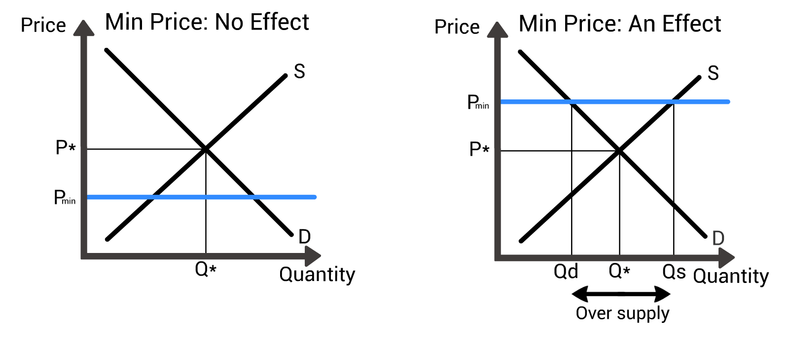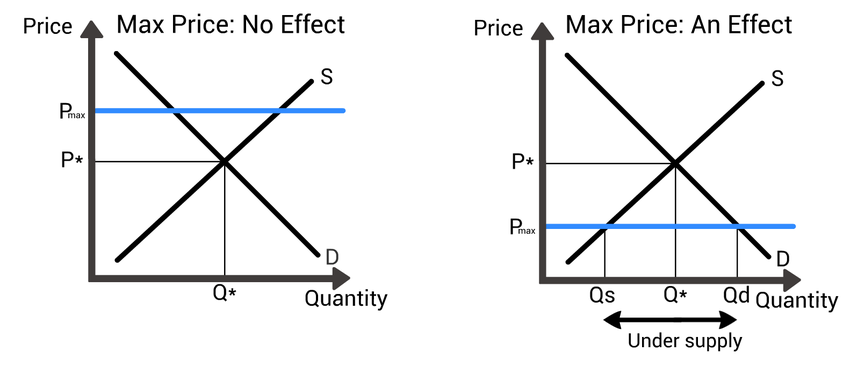2.7. EQUILIBRIUM & DISEQUILIBRIUM
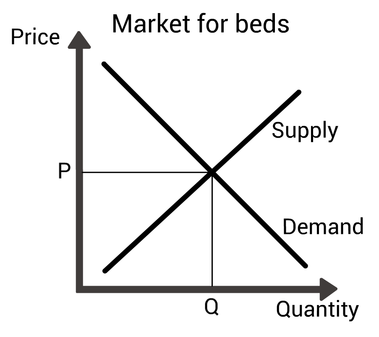 The market for beds will clear when supply intercepts demand.
The market for beds will clear when supply intercepts demand.
Equilibrium
Equilibrium is where economic forces are balanced. These economic variables will be unchanged from their equilibrium values, providing there are no external influences. An economic equilibrium is where supply equals demand and this is where the supply curve crosses the demand curve. We obtain the equilibrium price and quantity from the equilibrium. At the equilibrium there is no tendency for prices to change.
The market for beds clears at point where supply and demand intercept each other. This is where the price is P and quantity supplied is Q.
Now we know what the prices and quantities will be for markets, we can explore what happens when there are changes in different factors. These will be explored in the quiz section, as we want to test your knowledge of the whole of section two. There will be a video in this section explaining the answers.
Equilibrium is where economic forces are balanced. These economic variables will be unchanged from their equilibrium values, providing there are no external influences. An economic equilibrium is where supply equals demand and this is where the supply curve crosses the demand curve. We obtain the equilibrium price and quantity from the equilibrium. At the equilibrium there is no tendency for prices to change.
The market for beds clears at point where supply and demand intercept each other. This is where the price is P and quantity supplied is Q.
Now we know what the prices and quantities will be for markets, we can explore what happens when there are changes in different factors. These will be explored in the quiz section, as we want to test your knowledge of the whole of section two. There will be a video in this section explaining the answers.
Disequilibrium
Disequilibrium is where supply does not equal demand and this means that the economy doesn’t clear. This can occur for various reasons.
Disequilibrium is where supply does not equal demand and this means that the economy doesn’t clear. This can occur for various reasons.
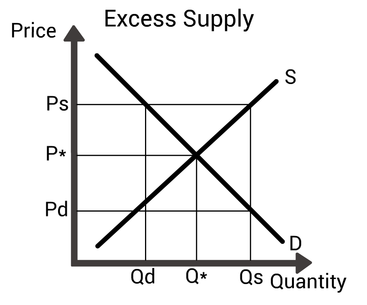 Here there is excess supply as firms have produce too much.
Here there is excess supply as firms have produce too much.
Excess Supply
Suppose now that firms decide to produce more than the equilibrium quantity because they thought the price would be higher due to a lack of information in the market. The market should be in equilibrium where prices are P* and quantity produced is Q*, but firms have produced Qs. Firms in the market have two options here. They can either sell at the price that they thought they could achieve Ps. At this price we can look at the demand curve and see that consumers are only willing to demand Qd therefore Qs minus Qd is not sold. This excess supply could be sold abroad or stored for next year. Another way to get rid of the excess supply would be to accept a price where Qs could be sold. Again this price is found by consulting the demand curve. If firms wanted to sell all of their goods that they have produced then they will have to accept price Pd.
Suppose now that firms decide to produce more than the equilibrium quantity because they thought the price would be higher due to a lack of information in the market. The market should be in equilibrium where prices are P* and quantity produced is Q*, but firms have produced Qs. Firms in the market have two options here. They can either sell at the price that they thought they could achieve Ps. At this price we can look at the demand curve and see that consumers are only willing to demand Qd therefore Qs minus Qd is not sold. This excess supply could be sold abroad or stored for next year. Another way to get rid of the excess supply would be to accept a price where Qs could be sold. Again this price is found by consulting the demand curve. If firms wanted to sell all of their goods that they have produced then they will have to accept price Pd.
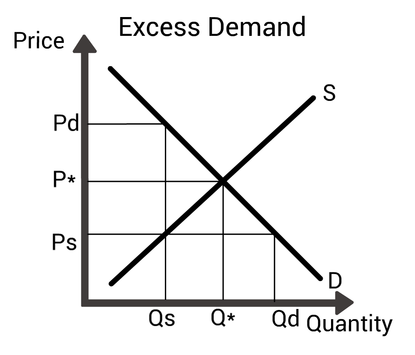
Excess Demand
Suppose now that firms did not produce enough of a good, due to adverse supply conditions. There is now a shortage in this market and the way to allocate the even more scarce goods than usual is to raise the price and sell these goods to the highest bidder. This results in a price rise from the equilibrium P* to Pd.
Suppose now that firms did not produce enough of a good, due to adverse supply conditions. There is now a shortage in this market and the way to allocate the even more scarce goods than usual is to raise the price and sell these goods to the highest bidder. This results in a price rise from the equilibrium P* to Pd.
Price Ceilings and Price Floors
Price ceilings and price floors are policies that can prevent the prices from becoming too high or too low. A price floor is also known as a min price. This is where the price in this market is not allowed to fall below a certain price. Every good in this market will be sold at this price or above. In the market for this good we can have both a binding and non-binding case. The non-binding case is where the min price is below the equilibrium market price. In this situation the min price has no effect on the market and the market functions as normal.
Price ceilings and price floors are policies that can prevent the prices from becoming too high or too low. A price floor is also known as a min price. This is where the price in this market is not allowed to fall below a certain price. Every good in this market will be sold at this price or above. In the market for this good we can have both a binding and non-binding case. The non-binding case is where the min price is below the equilibrium market price. In this situation the min price has no effect on the market and the market functions as normal.
The other case is where the min price is binding. In this case the equilibrium price will be below the minimum price, which cannot be allowed because legislation stops it from going that low. Therefore the price in the market will be Pmin. At price Pmin consumers are willing to buy Qd amount of goods and producers are willing to supply Qs amount of good, which leads to an over supply in this market.
A price ceiling is when the price in a market cannot go above a certain level. It is also know as a max price and we can have a binding and non-binding max price. In the unbinding case, the maximum price that can be charged is above the equilibrium. This means that this price ceiling has no effect on prices and output in the market.
A price ceiling is when the price in a market cannot go above a certain level. It is also know as a max price and we can have a binding and non-binding max price. In the unbinding case, the maximum price that can be charged is above the equilibrium. This means that this price ceiling has no effect on prices and output in the market.
Alternatively the price ceiling can be binding because the equilibrium price wants to be above the maximum price. In this case, the price will fall to Pmax and there will be an excess demand in the market. QD will be demanded and Qs will be supplied, which is why there is an oversupply in the market.

